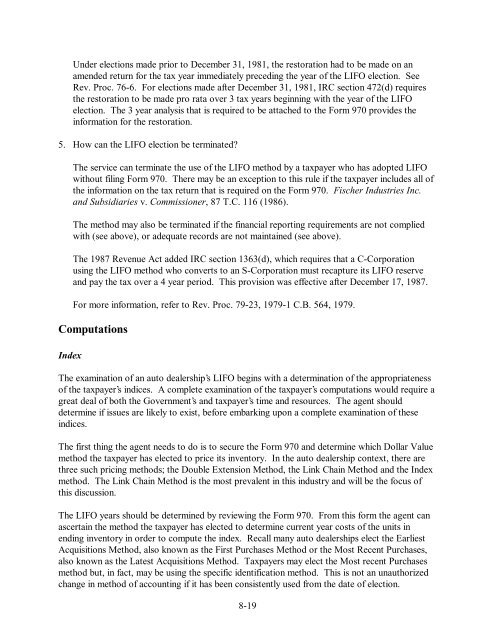Auto Dealerships - Audit Technique Guide - Uncle Fed's Tax*Board
Auto Dealerships - Audit Technique Guide - Uncle Fed's Tax*Board
Auto Dealerships - Audit Technique Guide - Uncle Fed's Tax*Board
Create successful ePaper yourself
Turn your PDF publications into a flip-book with our unique Google optimized e-Paper software.
Under elections made prior to December 31, 1981, the restoration had to be made on an<br />
amended return for the tax year immediately preceding the year of the LIFO election. See<br />
Rev. Proc. 76-6. For elections made after December 31, 1981, IRC section 472(d) requires<br />
the restoration to be made pro rata over 3 tax years beginning with the year of the LIFO<br />
election. The 3 year analysis that is required to be attached to the Form 970 provides the<br />
information for the restoration.<br />
5. How can the LIFO election be terminated?<br />
The service can terminate the use of the LIFO method by a taxpayer who has adopted LIFO<br />
without filing Form 970. There may be an exception to this rule if the taxpayer includes all of<br />
the information on the tax return that is required on the Form 970. Fischer Industries Inc.<br />
and Subsidiaries v. Commissioner, 87 T.C. 116 (1986).<br />
The method may also be terminated if the financial reporting requirements are not complied<br />
with (see above), or adequate records are not maintained (see above).<br />
The 1987 Revenue Act added IRC section 1363(d), which requires that a C-Corporation<br />
using the LIFO method who converts to an S-Corporation must recapture its LIFO reserve<br />
and pay the tax over a 4 year period. This provision was effective after December 17, 1987.<br />
For more information, refer to Rev. Proc. 79-23, 1979-1 C.B. 564, 1979.<br />
Computations<br />
Index<br />
The examination of an auto dealership’s LIFO begins with a determination of the appropriateness<br />
of the taxpayer’s indices. A complete examination of the taxpayer’s computations would require a<br />
great deal of both the Government’s and taxpayer’s time and resources. The agent should<br />
determine if issues are likely to exist, before embarking upon a complete examination of these<br />
indices.<br />
The first thing the agent needs to do is to secure the Form 970 and determine which Dollar Value<br />
method the taxpayer has elected to price its inventory. In the auto dealership context, there are<br />
three such pricing methods; the Double Extension Method, the Link Chain Method and the Index<br />
method. The Link Chain Method is the most prevalent in this industry and will be the focus of<br />
this discussion.<br />
The LIFO years should be determined by reviewing the Form 970. From this form the agent can<br />
ascertain the method the taxpayer has elected to determine current year costs of the units in<br />
ending inventory in order to compute the index. Recall many auto dealerships elect the Earliest<br />
Acquisitions Method, also known as the First Purchases Method or the Most Recent Purchases,<br />
also known as the Latest Acquisitions Method. Taxpayers may elect the Most recent Purchases<br />
method but, in fact, may be using the specific identification method. This is not an unauthorized<br />
change in method of accounting if it has been consistently used from the date of election.<br />
8-19
















